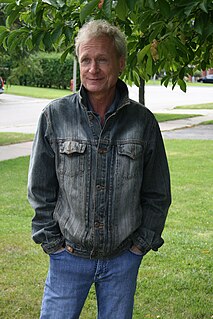Related Research Articles

Herbert Marshall McLuhan was a Canadian philosopher whose work is among the cornerstones of the study of media theory. He studied at the University of Manitoba and the University of Cambridge. He began his teaching career as a professor of English at several universities in the United States and Canada before moving to the University of Toronto in 1946, where he remained for the rest of his life.

The trivium is the lower division of the seven liberal arts and comprises grammar, logic, and rhetoric.

Harold Adams Innis was a Canadian professor of political economy at the University of Toronto and the author of seminal works on media, communication theory, and Canadian economic history. He helped develop the staples thesis, which holds that Canada's culture, political history, and economy have been decisively influenced by the exploitation and export of a series of "staples" such as fur, fish, lumber, wheat, mined metals, and coal. The staple thesis dominated economic history in Canada from the 1930s to 1960s, and continues to be a fundamental part of the Canadian political economic tradition.
Media ecology theory is the study of media, technology, and communication and how they affect human environments. The theoretical concepts were proposed by Marshall McLuhan in 1964, while the term media ecology was first formally introduced by Neil Postman in 1968.

Eric McLuhan was a communications theorist and media ecologist, son of Marshall McLuhan.

A sensorium (/sɛnˈsɔːrɪəm/) is the apparatus of an organism's perception considered as a whole, the "seat of sensation" where it experiences, perceives and interprets the environments within which it lives. The term originally entered English from the Late Latin in the mid-17th century, from the stem sens- ("sense"). In earlier use it referred, in a broader sense, to the brain as the mind's organ. In medical, psychological, and physiological discourse it has come to refer to the total character of the unique and changing sensory environments perceived by individuals. These include the sensation, perception, and interpretation of information about the world around us by using faculties of the mind such as senses, phenomenal and psychological perception, cognition, and intelligence.

The Gutenberg Galaxy: The Making of Typographic Man is a 1962 book by Marshall McLuhan, in which the author analyzes the effects of mass media, especially the printing press, on European culture and human consciousness. It popularized the term global village, which refers to the idea that mass communication allows a village-like mindset to apply to the entire world; and Gutenberg Galaxy, which we may regard today to refer to the accumulated body of recorded works of human art and knowledge, especially books.
David Carson is an American graphic designer and design director.

Walter Jackson Ong was an American Jesuit priest, professor of English literature, cultural and religious historian, and philosopher. His major interest was in exploring how the transition from orality to literacy influenced culture and changed human consciousness. In 1978 he served as elected president of the Modern Language Association.
Robert K. Logan, originally trained as a physicist, is a media ecologist.

Bruce William Powe, commonly known as B. W. Powe, is a Canadian poet, novelist, essayist, philosopher, and teacher.
Edmund "Ted" Snow Carpenter was an American anthropologist best known for his work on tribal art and visual media.

"The medium is the message" is a phrase coined by the Canadian communication theorist Marshall McLuhan and the name of the first chapter in his Understanding Media: The Extensions of Man, published in 1964. McLuhan proposes that a communication medium itself, not the messages it carries, should be the primary focus of study. He showed that artifacts such as media affect any society by their characteristics, or content.

Orality is thought and verbal expression in societies where the technologies of literacy are unfamiliar to most of the population. The study of orality is closely allied to the study of oral tradition.
Global village describes the phenomenon of the entire world becoming more interconnected as the result of the propagation of media technologies throughout the world. The term was coined by Canadian media theorist Marshall McLuhan in his books The Gutenberg Galaxy: The Making of Typographic Man (1962) and Understanding Media (1964). Literary scholar Sue-Im Lee describes how the term global village has come to designate “the dominant term for expressing a global coexistence altered by transnational commerce, migration, and culture”. Economic journalist Thomas Friedman's definition of the global village as a world “tied together into a single globalized marketplace and village” is another contemporary understanding of the term.
Harley Parker was a Canadian artist, designer, curator, professor and scholar - a frequent collaborator with fellow Canadian and communications theorist Marshall McLuhan.
The Toronto School is a school of thought in communication theory and literary criticism, the principles of which were developed chiefly by scholars at the University of Toronto. It is characterized by exploration of Ancient Greek literature and the theoretical view that communication systems create psychological and social states. The school originated from the works of Eric A. Havelock and Harold Innis in the 1930s, and grew to prominence with the contributions of Edmund Snow Carpenter, Northrop Frye and Marshall McLuhan.

War and Peace in the Global Village is a 1968 book by Marshall McLuhan and Quentin Fiore. It contains a collage of images and text that illustrates the effects of electronic media and new technology on man. Marshall McLuhan used James Joyce's Finnegans Wake as a major inspiration for this study of war throughout history as an indicator as to how war may be conducted in the future.,

The Mechanical Bride: Folklore of Industrial Man (1951) is a study of popular culture by Marshall McLuhan, treating newspapers, comics, and advertisements as poetic texts.
Adeena Karasick is a Canadian poet, performance artist, and essayist. Born in Winnipeg of Russian Jewish heritage, she has authored several books of poetry and poetic theory, as well as a series of parodic videopoems, such as the ironic "I Got a Crush on Osama" that was featured on Fox News and screened at film festivals, Ceci n'est pas un Téléphone or Hooked on Telephonics: A Pata-philophonemic Investigation of the Telephone created for The Media Ecology Association, "Lingual Ladies" a post-modern parody of Beyoncé's "Single Ladies", and "This is Your Final Nitrous" a poetic response to the Burning Man Festival., White Abbot, a parodic videopoem Karasick created during the writing of Salome dedicated to the impossible anguish of forbidden love, and Medium in a Messy Age: Communication in the Era of Technology created for the 71st Annual New York State Communication Association Conference and the Institute of General Semantics, 2013.
References
- ↑ "Marshall McLuhan: The Medium and the Messenger." Philip Marchand. 2014.